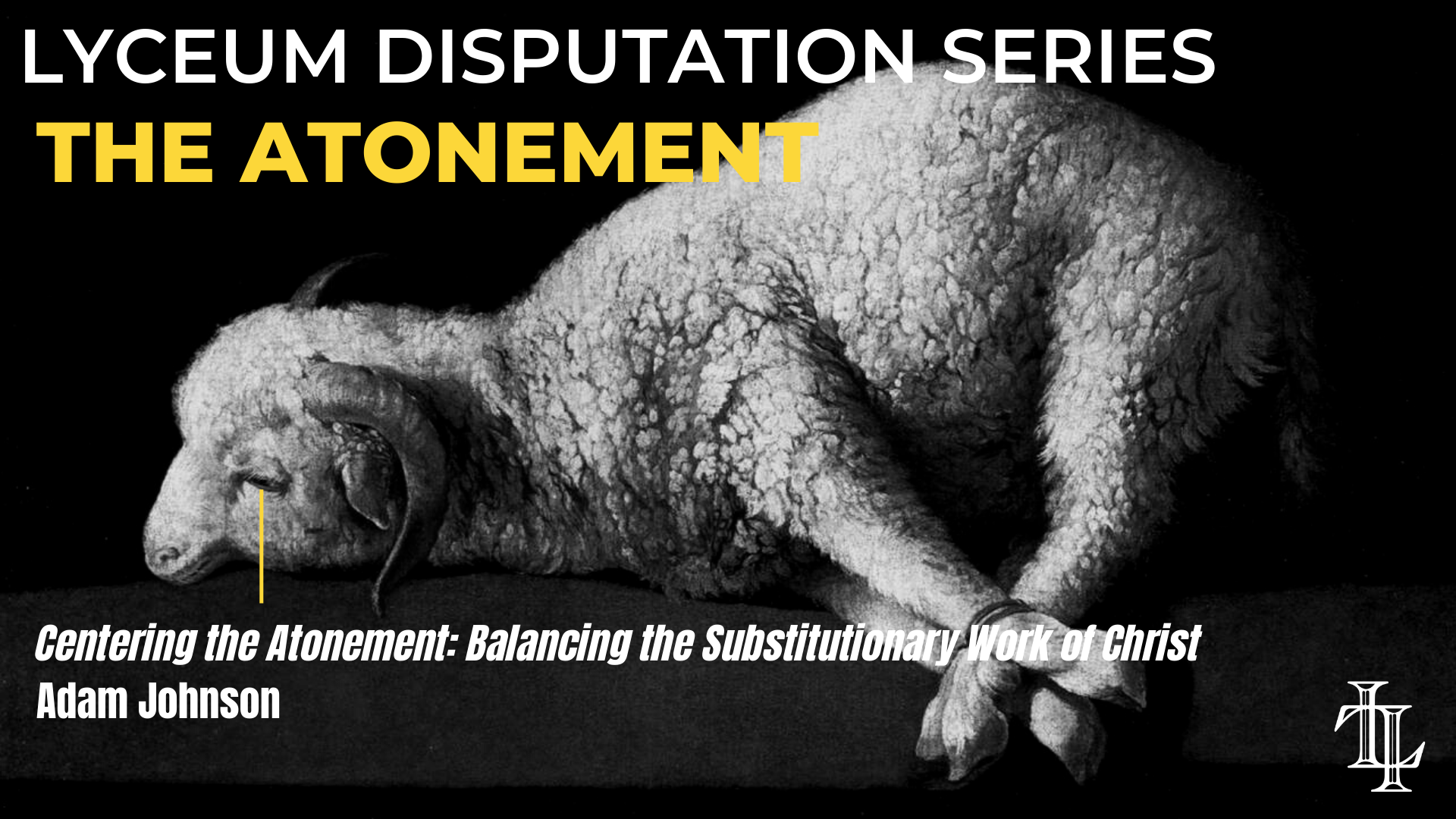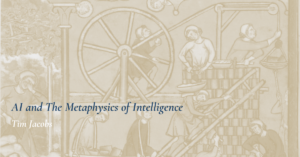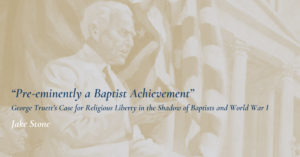Editor’s Note: This is part 2 in our Lyceum Disputation series considering the necessity of Penal Substitutionary Atonement as described in this 2017 SBC resolution. Stay tuned for further installments. As with all our work, the London Lyceum publishes a range of viewpoints to encourage thinking.
I have been asked to offer a response to the 2017 Southern Baptist Conference resolution on penal substitution.
The resolution is a response to “numerous voices from the Protestant world” that have boldly attacked the doctrine of penal substitutionary atonement. It is worth noting that this is nothing new. Criticisms have been levied against this view of the atonement for centuries, the most famous being that of Socinus. I recently read The Atonement in Modern Religious Thought, a theological symposium published in serial form in 1900—and in many ways little has changed in the last 120 years (an exception might be the feminist critique of traditional views of Christ’s atonement). If we can learn anything from the last 100 years, it is that the pressures facing penal substitution are perennial ones, which each generation in the church will need to come to terms with.
And if anything, there is reason, in the five years since this resolution was passed, for the Southern Baptists to be of good cheer. William Lane Craig, Tom McCall, Ross Hastings, Adonis Vidu and others have written works or chapters that offer significant defenses of penal substitution. Perhaps the most surprising such contribution comes from the Episcopal church: Fleming Rutledge’s The Crucifixion: Understanding the Death of Jesus Christ offers a strong and thoroughly traditional defense of penal substitution in many respects. The best arguments for penal substitution offer trinitarian and other grounds for showing with confidence that penal substitution is in no way “monstrous,” “evil,” “a terrible doctrine,” or indicative of “the Father murdering [his] son.”
It is important to remember that penal substitution is a synthetic doctrine: it is formed by the confluence of several different lines of thought in Scripture and theology. The doctrines of the trinity, Christology, hamartiology… nearly every major locus of the Christian faith plays a role in shaping this view of the atonement. Is God triune, or is he three gods? Is sin against him, and does he respond negatively to sin (in the form of judgment, destruction, etc…)? What is the character of God, and is any one attribute central in the life of God (mercy, love, justice, holiness, etc…?). To understand penal substitution is to understand a whole set of Christian commitments concerning the teaching of Scripture.
Because penal substitution is a synthetic doctrine, we must be careful in how we support it from Scripture. Many of the passages mentioned in the resolution are powerful and central passages for understanding Christ’s atoning work, but are ambiguous (at best) when it comes to supporting penal substitution per se. Indeed, Jesus is the warrior-savior who crushes the head of the serpent, he fulfills the OT sacrificial system, he came to serve and give his life as a ransom, his blood is precious and is a prerequisite for the forgiveness of sins…. But I would have preferred that the resolution exercise a good deal more nuance in this regard. All of the above statements are perfectly compatible with a number of views regarding the atoning work of Jesus, and do not speak to penal substitution per se at all.
The key is to understand how we “think” about the doctrine of the atonement. Some look for a main “theory” of the atonement—an explanatory core which then makes sense of other aspects or consequences of Jesus’ death and resurrection. Some think of the cross as bringing about a whole range of effects, one of which is (or might be) penal substitution. Others take a step further back, and think mostly in terms of the rhetoric with which we draw from cultural resources to give explanations of this event. I have argued for a version of the second approach (the cross brings about a whole range of effects) in Atonement: A Guide for the Perplexed and other writings, grounding this range of effects ultimately in the doctrine of the divine attributes.
The point to make at present is that while penal substitution is a vital part of the Bible’s explanation of the atonement, it is not the center, core or heart of the doctrine. First, the Bible can and does speak of the work of Christ without reference to substitutional/judicial/penal categories in many passages. Second, for this reason the history of theology can and does speak of the work of Christ without employing substitutional/judicial/penal categories in many works. Third, while God is just, justice is no more the “key” attribute of God than is mercy, patience, or omnipotence. Penal substitution is without question an integral part of the biblical witness to the meaning and efficiency of the death and resurrection of Jesus. But that does not mean that it is “the burning core of the Gospel message and the only hope of a fallen race.” It is, rather, a valid and significant aspect of the work of Jesus, alongside other equally significant aspects.
Take, for instance, the point that “God is perfect in His holiness (Isaiah 6:3).” What does it mean that this holy one became one of us, came among us in our uncleanness? He is the one who fulfills the sacrificial system in order to cleanse us. He is the priest. He is the sacrifice. His is the blood. He is the one who enters a more perfect temple, to accomplish a more perfect cleansing, that we might be clean—that we might be holy as he is holy (1 Pet. 1:16). Indeed and amen! But is this penal? Not in the least. The sacrificial system is not about punishing an animal—it is about properly using it and manipulating its blood, in order to both please God, and cleanse his people, his temple, his altar, etc. This account is not against an account of penal substitution, but it isn’t the same thing either—it is an equally valid and significant aspect of the work of Christ to come among us, take upon himself the consequences of our sin, that he might share with us the character of God—that we might be remade in his image.
Or take the claim, rooted in Isaiah 53:5, that “by his wounds we are healed.” Of course this can be understood as a metaphor for penal substitution (wherein physical ailments are part of our punishment). But notice how Augustine explains this concept:
And indeed that humble doctor came, he found the patient lying sick, he shared his infirmity with him, summoning him to share his own divinity; he became in his passion the slayer of passions, and dying he was hung on the tree in order to put death to death. He made a food for us, which we were to take, and be cured. Where does this food come from? Having died, he rose again. And whom does it nourish? Those who have imitated the Lord’s humility. (Sermon 341A, pp. 30-31)
The argument is one in which sharing is the fundamental logic (rather than substitution), and the dominant category is rooted more in divine impassibility and human passibility, rather than judicial categories of justice and guilt. The impassible God took up human passible flesh, that he might take our sickness unto death, and we in turn might share in the divine impassibility through partaking of his resurrection.
Everywhere in the history of doctrine one finds affirmations of something akin to penal substitution, alongside other explanations of the work of Christ which are equally valid, equally biblical, sometimes far more developed, but that are not rooted in God’s justice, his punishment of sin, and Christ’s vicarious taking upon himself of that punishment. Both Scripture and the history of theological reflection upon it affirm penal substitution and refuse to make it central at the expense of other aspects of Jesus’ saving work.
But what does it mean to reject penal substitution? It is one thing not to mention or develop it either explicitly or at length (as was true of much the history of the church prior to the Reformation and Socinus’ critique).
To explicitly reject penal substitution is quite a different matter from simply speaking of the cross in terms of other legitimate aspects of the saving work of Christ. Most charitably put, a rejection of penal substitution entails a responsibility to the following:
- to offer an account of the cross fully integrated with the doctrine of the Trinity, wherein the cross is both willed and accomplished by Father, incarnate Son and Holy Spirit
- to fully integrate the biblical account of God’s divine attributes (including his justice, righteousness and holiness) into one’s account of Jesus’ work. Included in this is the necessity of honoring Scripture’s witness to the negative mode of God’s attributes, such as wrath and hatred
- to unpack the nature of sin not merely in immanent terms (as an account of its natural consequences), but as a reality rejected, punished and judged by God
- to give an account for the substitutionary logic flowing throughout both Old and New Testaments
- to root the work of Christ in the necessity of both his death and resurrection
Anything less than this is to do as the resolution says: offer “false teaching that leads the flock astray, leaving “the world without a message of a sin-cleansing Savior.”
But to be clear—both the Bible and the church throughout its history have often explored the meaning and significance of the death and resurrection of Jesus in terms other than those of penal substitution. One can find logic akin to and harmonious with penal substitution in Leviticus, Proverbs and Hebrews, or in the works of the Apostolic Fathers, Irenaeus, Athanasius, Anselm, Aquinas and others—but in which the dominant patterns of thought are not those of penal substitution. And this is perfectly legitimate and good, because the atoning work of Jesus Christ is a complex work, reconciling all things in heaven and earth. There is far more to this work than penal substitution.
But to reject penal substitution is another matter altogether. Perhaps it can be done responsibly, but most often entails rejecting commitments central to the biblical witness, in favor of something we construct more in our own image and to our own liking than what is revealed to us by Holy Scripture.
And what happens when we make penal substitution “the burning core of the Gospel message and the only hope of a fallen race”? By doing so, we put others with whom we have much in common on the defensive. By needlessly creating a polarizing perspective we push friends and allies away, and push those among us away who have questions and doubts not about what we affirm, but about the imbalances and distortions we have introduced by making something true and valid the central or driving concern. For ultimately, creating such an imbalance pits Scripture against Scripture, generating an environment in which one can affirm certain claims in Scripture and yet feel that one is opposing the teaching of the church, creating an unstable and untenable situation.
I applaud the Southern Baptist Conference for seeking to defend penal substitution. I find that this teaching is both biblical and affirmed widely throughout church history among Roman Catholic, Orthodox, Lutheran, Anglican, and Wesleyan theologians. I defend the doctrine in various writings, including the forthcoming article on “Jesus as Substitute” for the St Andrews Encyclopaedia of Theology. But I fear that making penal substitution the central aspect of Jesus’ saving work creates unnecessary imbalances and tensions which may generate more harm than good.
- It creates ecumenical tensions, alienating friends from other branches of the church.
- It creates tensions among proponents of penal substitution, who want to affirm this doctrine while simultaneously wanting to uphold with full integrity other biblical aspects of the work of Christ.
- Most of all, it creates tensions in our reading of Scripture, where we must fill in gaps or re-interpret or re-contextualize key terms or concepts so as to fit them within an account of penal substitution, this missing the full breadth and diversity of the Bible’s teaching about the work of Christ.
Penal substitution is one true aspect of the saving work of Jesus Christ—one which we should seek to understand, praise, and defend. But the atonement is a bigger doctrine than penal substitution, and we do ourselves, the church and its worship a disservice when we seek to make penal substitution the central teaching of the church.
Author
-

Adam Johnson (PhD, Trinity Evangelical Divinity School) is a theologian who focuses on the doctrine of the atonement, exploring the many ways in which the death and resurrection of Jesus Christ effect the reconciliation of all things to God. He and his family lead the Torrey National Parks class every summer.
View all posts



